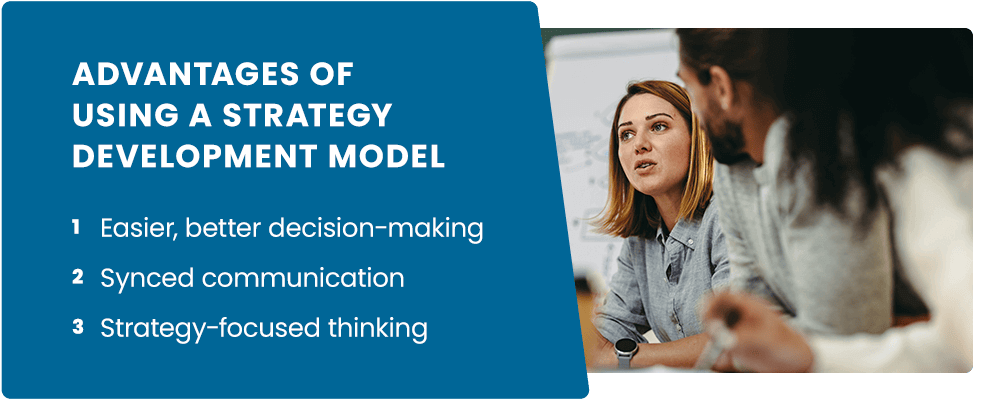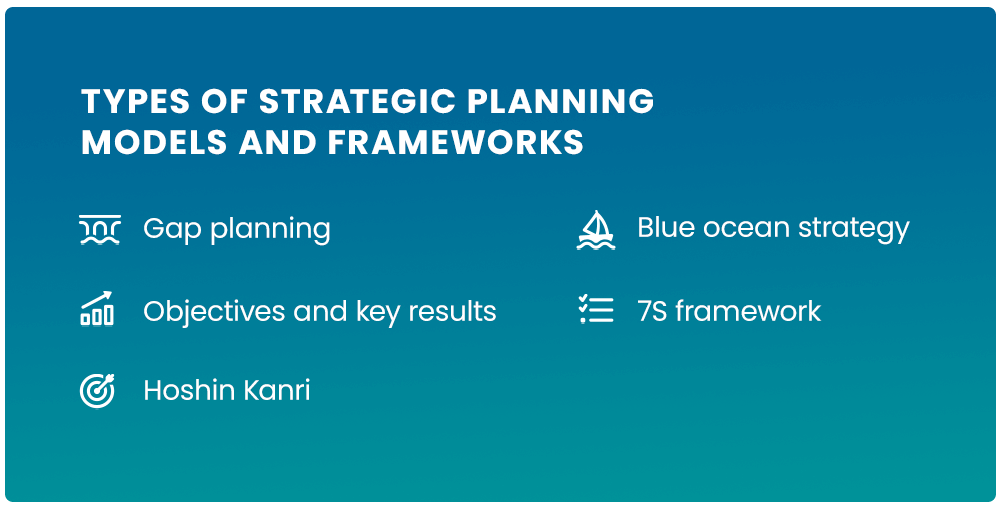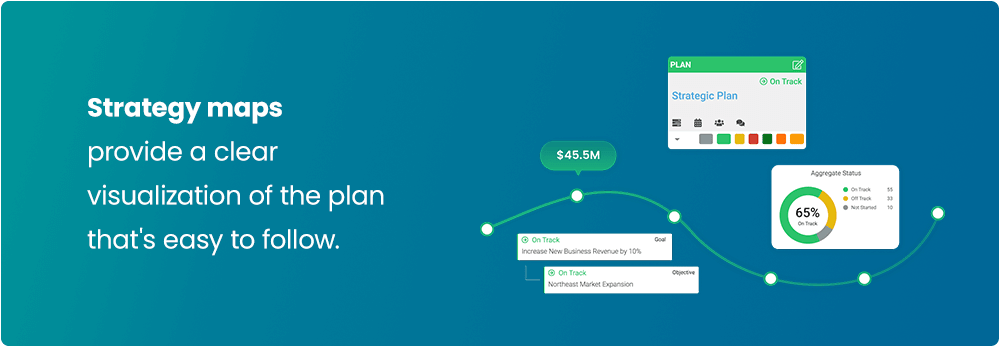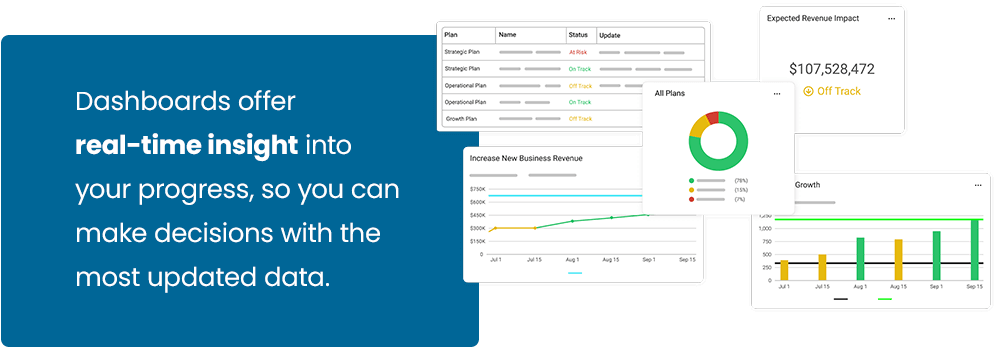Like several areas of business, strategy planning can come in many forms. Numerous professionals have contributed to the conversation, designing models, frameworks, and tools to accommodate different companies and goals. Since every organization is unique, a wide selection allows you to find resources that fit well, offering the right focus areas and strengths for your needs. But it can also be a little daunting.
To help you find the best resources for strategic planning, we’ll explore some popular models and frameworks and valuable planning, management, and tracking tools.
In This Article
- What Are Strategy Development Models?
- Types of Strategic Planning Models and Frameworks
- 13 Incredible Strategic Planning Tools
- How to Choose the Best Strategic Plan for Your Organization
- Simplify Your Goals and Boost Productivity With AchieveIt’s Strategic Planning Solutions
What Are Strategy Development Models?
Strategy development models provide an outline to help businesses identify goals and implement a strategy to achieve them. The process and results can vary widely, but a strategy development model usually involves a template or framework to help you build the plan. Many models extend from planning to implementation, offering guidance for carrying your strategy through these other stages.
These strategic models start by adding objectivity to your company’s mission, values, and goals. From there, you have a clear purpose to which you can guide future decisions. As you build your strategy, you can turn to your findings — which have been carefully selected and agreed upon — to inform the small choices you’ll need to make. You will also use your plan as an anchor point when assessing and improving your strategy.

Some of the advantages of using a strategy development model include:
- Easier, better decision-making: These models provide go-to, indisputable purposes by defining objectives and strategies from the start. Stakeholders can make their decisions with these goals in mind, making navigating competing demands and complex business processes easier.
- Synced communication: Similarly, these models are ideal for creating a summary of the plan and goals and sharing it among the business. Everyone involved, from executives to interns, has a clear image of what to work toward and understands the “why” behind the strategy.
- Strategy-focused thinking at all times: It’s easy to keep your strategy front and center for a few weeks after you make it. Many strategy development models include elements of continuous improvement, helping businesses continue to make progress toward goals. Strategic planning tools also offer visual aids, which can help provide concise references to remind the team what’s important.
Types of Strategic Planning Models and Frameworks
Although the two terms are often used interchangeably, strategic planning models and frameworks refer to two distinct resources. A model is a detailed map of the organizational strategy, typically defining every element in detail. A framework, however, is a visual representation of the model, providing a broad overview of the plan and its components. Both can be valuable tools for reaching your goals, but you’ll need to use them correctly.
Below are some examples of strategic planning models and frameworks to consider using in your business.
1. Gap Planning
Gap planning — also called a strategic-planning gap, needs assessment, or need-gap analysis — identifies the gap between where an organization is and where it wants to be. Gap planning then focuses on how the business can fill that gap. This model is a good fit for organizations that need to find deficiencies.
2. Objectives and Key Results
Objectives and key results (OKRs) is a popular and straightforward model that focuses on alignment and engagement across the team. All levels of management must sign off on a set of OKRs, which then inform the measurable goals. The objectives include several goals — often inspired by SMART Goal methodologies — and three to five key results to accompany each one and measure progress.
OKRs is a fast-paced and adaptive option, making it a good choice for organizations that want to track and evaluate progress toward goals. As goals change and the organization grows, OKR is easy to modify.

3. Hoshin Kanri
Hoshin Kanri promotes consistent direction and strong communication at every level. It gets everyone, including corporate executives and operational staff, pulling in the same direction for more coordinated and effective efforts. This method prioritizes goals and initiatives over measures.
4. Blue Ocean Strategy
The Blue Ocean strategy comes from a book of the same name by Chan Kim and Renée Mauborgne. They outlined a strategy designed to help businesses carve out a space in a less-competitive market rather than a highly saturated one. Companies aim to move from a “red ocean” — a known, defined, and saturated market — to a “blue ocean,” an all-new industry without competition or constraints.
This unique tactic could create significant advantages for organizations that can make it work.
5. 7S Framework
McKinsey developed the 7s framework, which aligns and reinforces seven internal factors of an organization. The factors help determine whether the business has the necessary structural support for success.
The seven elements include:
- Strategy
- Structure
- Systems
- Shared values
- Skills
- Style
- Staff
When viewed together, the framework helps link these aspects to boost synergy and meet strategy goals. While the 7S model works well in many situations, it can be especially useful for organizations facing disruption or change in any of the elements, such as during a merger or acquisition.
13 Incredible Strategic Planning Tools
A strategic model is one part of the puzzle, and you can find all sorts of strategy development tools to help you build your plan. Some of them are used within the plans mentioned above, while others work well as standalone resources. Either way, these tools can provide valuable benefits for the planning process and the following stages. Since they focus on different goals, we’ll break down our tool list into resources for planning, management, and tracking.
Planning Tools
Planning tools can help in many different areas, from visualization to granular analysis. Some popular planning resources include:
- SWOT analysis: SWOT refers to strengths, weaknesses, opportunities, and threats. This kind of analysis helps to identify internal and external factors that affect a company’s chances of success. It’s a high-level tool used early on in the planning process. A SWOT analysis can be presented as a table with four quadrants, one dedicated to each section of the acronym. You can find free SWOT templates online to make this tool even easier to use.
- PEST or PESTLE: The PEST model investigates political, economic, sociocultural, and technological factors that could affect operational health. PESTLE adds legal and environmental elements. Many companies use PEST or PESTLE alongside SWOT for a comprehensive analysis of influential aspects.
- VRIO: Rounding out our acronym-based tools is VRIO, which stands for value, rarity, imitability, and organization. VRIO aims to identify the assets that make your organization stand out in the market. It can help you cultivate a stronger vision and make a plan that maximizes the value of your resources.
- Strategy maps: A strategy map is a visual representation of your strategy. It usually takes the form of a diagram to connect strategies and objectives and show the progression of high-level business goals. Strategy maps are easy to share and provide a digestible image of the strategy.
- Porter’s Five Forces: The Five Forces tool helps businesses identify various forces that impact operations. It has a special focus on competition and the landscape of a given industry. Porter’s Five Forces include competition in the industry, the potential threat of new industry entrants, suppliers’ bargaining power, customers’ bargaining power, and the threat of substitute products.
- The Ansoff Matrix: Also called the Product/Market Expansion Grid, the Ansoff Matrix is a simple two-by-two table that helps with identifying and evaluating growth initiatives and the associated risks. You can see in this example how it places new and existing products and markets on each side, with strategies that correspond to increasing risks. These strategies include market penetration, market development, product development, and diversification. Businesses focused on growth can use the matrix effectively.

Management Tools
Management tools move into the implementation step and support businesses in successfully executing strategic plans. They might help in areas like communication, visualization, and accountability.
Common management tools used in strategic planning include:
- Strategy maps: We mentioned them earlier as a planning tool, but strategy maps can help during management, too. They provide a clear visualization of the plan that’s easy to follow. You might use a strategy map that appears as a tree, list, Gantt chart, dashboard, or another design.
- Project plan templates: Project plan templates allow you to save time with pre-built resources designed for popular strategic planning techniques and frameworks. Simply plug in your information and start analyzing.
- Business model canvases: A business model canvas identifies key elements of a business, like activities, resources, and value propositions. It offers a simple, at-a-glance executive summary that you can use during management to keep your image of the company up-to-date. A business model canvas template provides a streamlined view of the different elements.
- Integrated plan management: Integrated plan management requires a platform that connects with your company’s other systems and links activities together. This resource can greatly simplify management, providing a single source of truth for actions related to plan execution.
Tracking Tools
When assessing the results and progress of your strategic plan, tracking tools can make a considerable difference. They can help you monitor performance metrics, employee activity, and other relevant aspects of your plan.
Here are some helpful tracking tools to consider when executing and evaluating your plan:
- Dashboards: A customizable, comprehensive dashboard is an excellent resource, especially for more complex strategies involving many moving parts. Dashboards offer real-time insight into your progress, so you can make proactive decisions with the most updated data and an easily understandable display of information.
- Balanced scorecards: A balanced scorecard measures performance with a set of metrics designed for balance. Rather than focusing solely on short-term financial performance, this scorecard includes non-financial strategic metrics, such as internal processes, customer satisfaction, and growth. It offers a good reflection of progress toward long-term success. A balanced scorecard can be used with several perspectives, like financial and stewardship or internal process perspectives.
- Integrated plan management: Here’s another tool that works well in multiple stages. Integrated plan management is especially valuable during tracking, pulling information into one place and providing accountability. Updates occur automatically with a standardized reporting structure for visible, easy-to-understand management.
How to Choose the Best Strategic Plan for Your Organization
Finding the right strategic planning tools and frameworks for your organization can streamline the process and greatly improve your chances of success. Before you make these decisions, spend some time figuring out how your organization ticks. What problems do you want your plan to solve? What characteristics of your organization, like size and industry, will affect planning? What does communication look like in the business? Do you have the strategy development tools you need to execute your plan?
Answering these questions can help you identify a good fit from the models and tools listed above. For example, if you have a large, diverse business and can’t seem to figure out why you can’t meet your goals, you might consider gap planning or Hoshin Kanri. Gap planning identifies roadblocks, while Hoshin Kanri focuses on synchronizing business activities and communication. Remember to factor in all stages of a strategy, from planning to execution, and include tracking and management tasks.

Not sure where to start? Try the following steps:
- Determine your expectations: Spend a little time figuring out what you want from your plan. Is it going to be a loose guide to the future or a rigorous timeline that will guide business decisions? Are all of your stakeholders on the same page? Make sure everyone knows what to expect from the plan.
- Find your goals and objectives: If goal-setting isn’t already a part of your future planning method, revisit them and ensure alignment. They’ll help you set your strategy and provide a shared purpose.
- Create an action plan: With the help of the above models and tools, connect your strategy to an action plan with steps, goals, and a timeline to guide your business forward.
- Provide a single-page summary: If you want your strategy to stay top-of-mind, you can’t bog down the reader with pages of information. Turn your strategy plan into a one-page summary, ideally with the help of visualization tools, to disseminate the information quickly and support visibility.
- Prioritize communication: Similarly, your plan should extend across all levels of the business. Communication can include everything from assigning tasks to receiving real-time updates. Keep good communication a priority throughout management and execution.
- Be open to change: As your business evolves or the industry changes, your plan may need some tweaking. Keep an open mind about your plan, and make adjustments if needed.
Whichever model or framework you end up using, these tips can help you make the most of it. If you’re not sure which one is right for your organization, you can always turn to a professional. AchieveIt’s strategy services, for example, allow you to partner with our strategy experts to create and execute tailored plans.
Simplify Your Goals and Boost Productivity With AchieveIt’s Strategic Planning Solutions
At AchieveIt, strategy planning is what we do best — in several capacities. We offer resources, such as strategy maps, real-time dashboards, and integrated plan management, through the AchieveIt plan execution platform. We also provide expert strategy consulting services to help you reach your goals as effectively as possible.
Learn more about how AchieveIt works with our live product tour, or reach out today to talk with a team member! Reach your full potential with AchieveIt.



